In the Movies with Gerhard Fromm
|
Read more
at in70mm.com The 70mm Newsletter |
| Written by: Thomas Hauerslev. Transcribed for in70mm.com by Brian Guckian, Ireland. Proofread by Gerhard Fromm for accuracy. | Date: 16.02.2012 |
 The
team behind this conversation, Gerhard Fromm (sitting), Orla Nielsen (left) and
Thomas Hauerslev (right) The
team behind this conversation, Gerhard Fromm (sitting), Orla Nielsen (left) and
Thomas Hauerslev (right)Thomas Hauerslev (THa): Tell us about your background and how you got involved in movies ... like the story you told me earlier today about the photo shop, the developer laboratory ... can you tell me that story again? Gerhard Fromm (GF): Yes, I was working in the photo shop as a special dealer, you know a specialist, and one day a lady came in and she wanted a film. It was very unusual that she wanted a negative film because in those days if you wanted to take pictures in colour you had to use slide films. And she told me that DEFA laboratories say “make pictures”, so she invited me to visit the company and I was told that they were looking for people to build them up as photo laborant [lab technicians]. And so I went there and I saw that this was a fantastic new thing, and I cancelled my job at the photo shop and went to DEFA. They gave us time for making; learning. For example, I got in as a Projectionist, also in the colour lab and also as a camera technician; so that was a very good time. But then I wanted to go to West Germany and I looked at Arnold & Richter’s in Munich and they were looking for a colour grader; so I started working at Arnold & Richter’s. |
More
in 70mm reading: A Visit to ARRI in München Re-visiting Large Format With Gerhard Fromm The Work of Jan Jacobsen The M.C.S.-70 Process and European Cinema of the 1960s MCS 70 Field Camera MCS 70 Superpanorama Films Adverts and posters Internet link: 16.02.2012 Great, great story about Gerhard!!! Best Robert Weisgerber Hollywood 16.02.2012 Wonderful your Gerhard Fromm report. Cheers Gerhard Witte Berlin |
 Gerhard
demonstrating a camera. Image by Thomas Hauerslev Gerhard
demonstrating a camera. Image by Thomas HauerslevTHa: When was that? GF: ’57. THa: When were you born compared to you working in the shop? GF: I was born 1932 in Berlin. THa: So, you came to Arnold & Richter in München. And what were your duties at Arnold & Richter? GF: Yes I had to colour grade films, you know feature films and documentaries, and all that stuff. THa: How many years did you work for Arnold & Richter? GF: I think it was only one year. |
The company in Zürich : Vergnügungsbetriebe Zürich Edy W Meier Stöckenstr. 29 CH-8903 Birmensdorf / ZH Tel : 0044 - 737 2055 Jan had adapted the Studio MCS-Cameras to 3-D System with two cinemascope lenses, both pictures side-by-side on one 70mm frame! |
Camera Assistant |
|
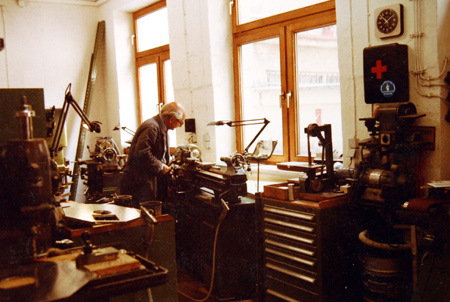 Gerhard
Fromm in his machine shop. Gerhard's collection Gerhard
Fromm in his machine shop. Gerhard's collectionTHa: And then what happened? GF: One of the Cameramen I was grading for ... documentaries and stuff like this, he came in and he said he wanted to make his first colour film, and invited me to go with him and teach him the systems, the colour system. And on the other hand he wanted to build me up as a camera assistant, so I went to Turkey, and after that we became friends. And I went with him I think 3 years. We had more time in Turkey than in Germany. THa: What kind of films did he make? GF: Something like documentaries – in those days you had a possibility to make short films; every cinema had to run short films before the main film. So when they showed these “cultural films” they had to pay less duty. So it was a very good business, and people wanted to see foreign countries; no-one was able to go to foreign countries in those days, so they went to cinemas like mad to see these films from different countries. And then we also made feature films. We taught one company in Istanbul to start up a film company and made one film with a Turkish producer; Şoför Nebahat was its name. It was a story about a woman that becomes a taxi driver; in those days, women couldn’t work anywhere in Turkey; second class people, all this sort of thing. And for the documentaries we saw more than most of the Turkish scene; all their life. We went all around to the far west and far north, and also to the border of Iran; everywhere shooting. It was very interesting. THa: Can you tell us about what cameras you used and what films? GF: Only one Arriflex 2B. THa: OK. |
|
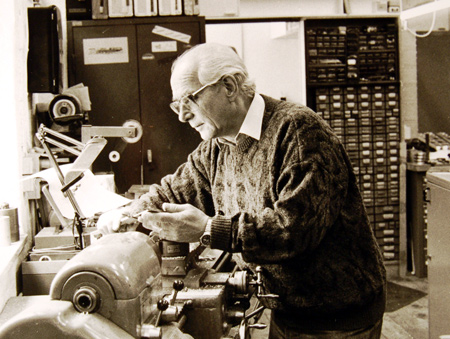 Gerhard
Fromm in his machine shop. Gerhard's collection Gerhard
Fromm in his machine shop. Gerhard's collectionGF: It was only – I think we had 3 lenses because the producer had not money, not too much money... THa: How many films came out of this expedition? GF: I think 3 films we made. THa: Do you know – are the films still available? GF: I don’t think so...no...I never heard of those. THa: They’re lost. GF: They were black-and-white, the first ones. Later we made colour films but I think they are not so interesting. |
|
 Gerhard
Fromm in the middle on the set of "Uncle Tom's Hütte" in MCS 70. Gerhard's
collection Gerhard
Fromm in the middle on the set of "Uncle Tom's Hütte" in MCS 70. Gerhard's
collectionTHa: So you went to Turkey...and what kind of skills did you learn from that experience? GF; Yes we just – you know when we saw something interesting – or when people told us, “You have to go to Pamukale”, we went there and took some pictures. So we went all around, looking for beautiful scenery. THa: What happened when you came back to Germany? Where were you staying - did you live in München? |
|
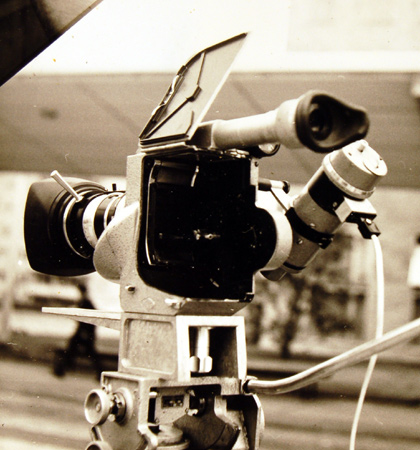 DDR
DEFA 70 70mm camera from the filming of "Du Bist Min", which Gerhard
also worked
on. From Gerhard's Collection. DDR
DEFA 70 70mm camera from the filming of "Du Bist Min", which Gerhard
also worked
on. From Gerhard's Collection.GF: I lived in Munich, always, Yes. And then I had a very good contact to one studio, and the manager of the studio gave me very good possibilities. He told me when you have a film and you want to go as an assistant, leave. But when you are coming back and you have no job, you can work here any time. Because he needed a Projectionist, to show the daily rushes. Even in England when the shooting was ready they had a screening every evening, and so it was very easy. I was working as an assistant and in the evening I was able to show the films because I had the permission, I had the card. THa: Yes. GF: It was good for him and it was good for me. THa: Was that during the 60s or where are we? GF: Yes it would – during the 60s. Yes, that’s correct. |
|
Working in Bavaria Studios |
|
 Gerhard
telling stories about his life and work. Image by Thomas Hauerslev Gerhard
telling stories about his life and work. Image by Thomas HauerslevTHa: What did you do after that? You told me upstairs that you have classes. Do you do teaching? GF: Oh this is much later – no, in those days I started as a camera assistant for bigger movies and also at the various studios for big shows. I was some years every day from morning till evening at Bavaria Studios. There was one man, the director Michael Pfleghar, he was very famous. He made all the big shows for television. So we were very busy in those days, and then I had good luck because at Bavaria Studios they started to make international productions with money from - how do you say - saving duties...that is to say, if you put the money in the film business, then you had to pay less duty, taxes, and people, you know like doctors or lawyers, etc., they invested money into the film business and then they got something back – sometimes, sometimes not! THa: Screen craze! GF: But this was a business like for many years...they had the possibility to make this. We made a very big film, "Twilight’s Last Gleaming", an American film with Bob Aldrich as the director and we shot every shot with two cameras, 35mm. This was money, you know they had money, unbelievable. We had - how many? - 180 kilometres of film for one 90 minute film. It’s unbelievable. THa: Much money - GF: Much money, yes. |
|
MCS 70 Superpanorama |
|
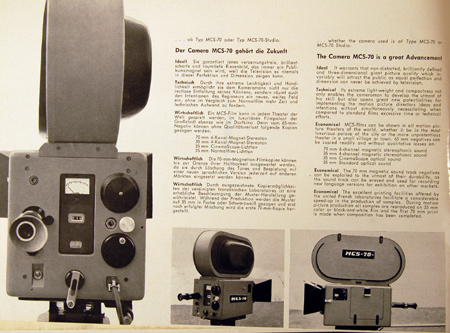 Part
of a MCS-70 brochure. Image from Gerhards collection Part
of a MCS-70 brochure. Image from Gerhards collectionTHa: In the ‘60s, there was something called MCS 70. Can you tell us the story about MCS 70, how it came about? GF: Yes, I had a friend Peter Rohe and he was technician, a camera technician with MCS 70 - Modern Cinema System. This was invented by Jan Jacobsen, and accidentally he met Mr. [Rudolf] Englberth from Royal Cinema [Royal Film-Palast, Munich] and he wanted to build a European camera, a German camera for the 65/70mm format. And there was a very rich man, Mr. Travnicek [film producer Rudolf Travnicek], who came in on this company. So they started to build it. Jan Jacobsen took his field cameras for MCS. It was very robust, and for this format, a very small camera. So they started to make a film, just as a test film, "Flying Clipper", and I didn’t work on "Flying Clipper" but later on I met Jan Jacobsen and so I came onto the production "Uncle Tom’s Cabin" as an operator, and one year later also for "Der Kongress Amüsiert Sich". And it was a very interesting job, with Heinz Hölscher who was the DoP. So it was very interesting, a good time. |
|
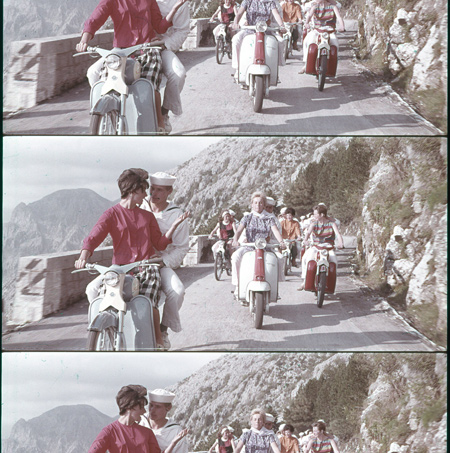 Faded
70mm frames from "Flying Clipper". Faded
70mm frames from "Flying Clipper".THa: What about the cameras...can you explain...were they different from Todd-AO and Mitchell and Panavision cameras? GF: The MCS camera was much smaller than all the others in the business, and they were rented out. MCS didn’t sell the cameras to anybody; they rented them out, and always with one technician to control the system. So the cameras went to Yugoslavia and there was made from Karl May’s novel the film "Old Shatterhand", and also to England, always with a technician. So because Peter Rohe was a technician at MCS he heard that they need an operator for "Uncle Tom’s Cabin". So I came onto the production and I was called to go to Belgrade and Ljubljana. It was a very interesting film. THa: Did you meet some interesting people on the production - like Herbert Lom? GF: Yes of course, we worked together every day and we had - often we had lunch together or dinner...mostly dinner. And also OW Fischer, people like that. You had contact with them. |
|
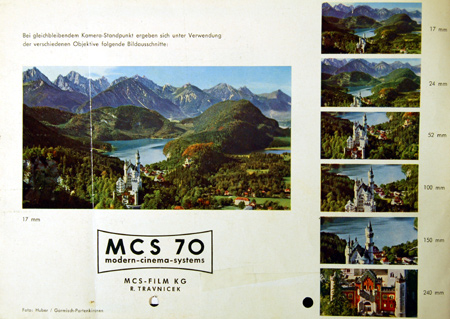 Page
from a MCS-70 general brochure. Image from Gerhards collection Page
from a MCS-70 general brochure. Image from Gerhards collectionTHa: How many cameras were used on a production in – like "Uncle Tom’s Cabin"? GF: I think we had two field cameras and nearly at the end of the production we got one of the sound cameras. The Studio - it was MCS70 S-Studio, and it was a test for the new blimped cameras I think because it was not there the full time. But I shot some pictures with the blimped camera. THa: Can you tell us about how the cameras were made? GF: Yes, of course. It was made by Jan Jacobsen with Mr. Schoenberger, he had a little machine shop, and they started with two cameras. They were out on a film and when they came back, they got some information, some feedback, and so they started to make two more and changed some things, based on what came back from the cameramen. And after that, when these cameras were tested on the set they came back with some more new ideas. |
|
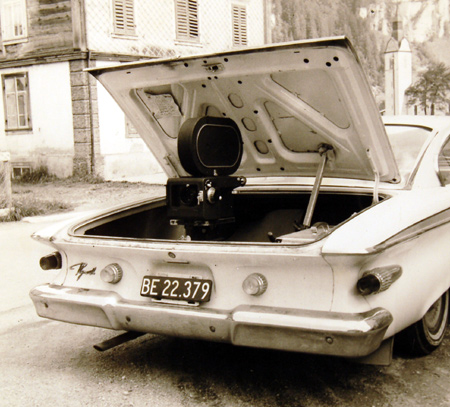 Filming
in MCS-70 from a trunk of a car - with a Danish license plate. Image from
Gerhards collection Filming
in MCS-70 from a trunk of a car - with a Danish license plate. Image from
Gerhards collectionSo they made two more cameras that had more changes. So these cameras were not all the same; you couldn’t take parts from one camera in the other, and so on. It was impossible because you always had to have the same pair; number one and two, or number three and four, or number five and six; it was not a production camera like Arriflex. But the movement was always the same; that was interchangeable. The movement was one block, and it was correctly adjusted. So this was a very solid work. THa: Can you tell us a little about the lenses they used? |
|
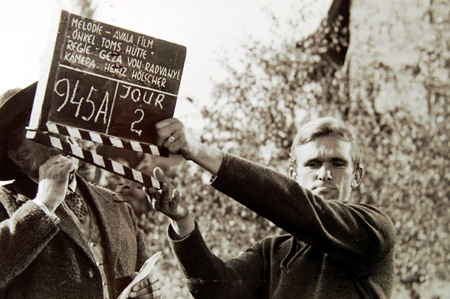 From
the filming of "Uncle Tom's Cabin" in MCS-70. Image from Gerhards collection From
the filming of "Uncle Tom's Cabin" in MCS-70. Image from Gerhards collectionGF: As far as I remember they used Hasselblad lenses. And in the beginning Hasselblad had the camera with – what do you say – schlitzverschluss [focal-plane shutter]. The lenses were just like a normal lens, not the Hasselblad system. THa: Did you change lenses a lot, or did you use mostly one or two lenses? GF: No, we had four or five lenses, and we changed many, many times. THa: Can you tell us about when the system started approximately early 1960s until they stopped or shut down the MCS70 company? GF: I don’t remember...I remember that Mr. Travnicek died and Mr. Aldo Von Pinelli, he also was a music agent and had made a lot of money with music, he had given the money for "Uncle Tom’s Cabin" and "Der Kongress", and when Aldo Von Pinelli died the company went down and cameras were sold, nobody knows. One is in France, in a lab, one was at NASA. Or two? - Nobody knows. |
|
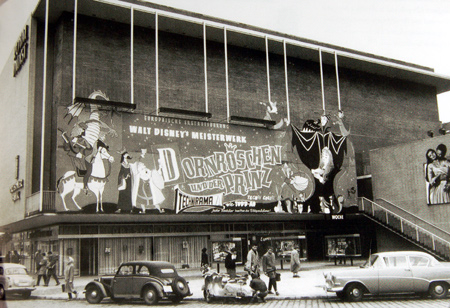 Munich's
Royal Palast cinema. The full-length cartoon feature film "Dornröschen und
der Prinz" (Sleeping Beauty) opened there on 30 October 1959. MCS 70 was first shown
here. Image from Gerhard's collection Munich's
Royal Palast cinema. The full-length cartoon feature film "Dornröschen und
der Prinz" (Sleeping Beauty) opened there on 30 October 1959. MCS 70 was first shown
here. Image from Gerhard's collectionThere is no information about the cameras, I only know that two studio cameras had been adapted to the 3D system by Jan and they went to Zurich, to a company called Vergnügungsbetriebe Zürich, and they were used for those tent cinemas, for the amusement parks. THa: Was it re-built for 3D systems? GF: Yes, this was for 3D, and the thing was there were two lenses, CinemaScope lenses, close together, and both pictures were on one film frame. One film frame had two pictures for the left and the right eye, so it was possible to produce – project - it with one projector in front of this special projection lens. They had two polar filters of course; this was the system. |
|
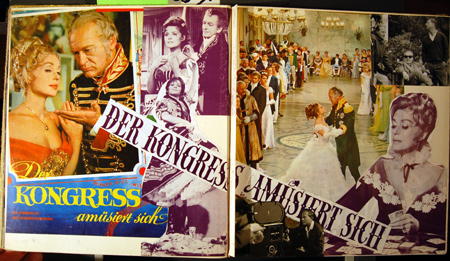 Souvenirs
from MCS 70. Image from Gerhard's collection Souvenirs
from MCS 70. Image from Gerhard's collectionTHa: Did you see any of the films? GF: No. Not near – I don’t know. There had been so many films on at Oktoberfest. But I don’t know, maybe it was cinema MCS or...there was another company in Switzerland, they made different cameras. Swissorama – the round picture with the special lens. It was also 65mm negative, but I think 10 perf, because the camera was standing on a glass, and the lens was hanging down, and took only around the horizon picture. The lens was one of these 220 degree lenses, Nikon lenses. And so, because the camera was standing sideways, looking down, and through the glass, they took just the ring around, all 360 degrees, without any line in between. And this was shown in Berlin, in a special building. It looked like a...space shuttle, or something. But the picture was terrible. The height was a ring, the film was a ring, and the height of the picture was about 9mm, like a 16mm frame. And in the cinema there was a projector with the same lens hanging down and showing all around – the picture all around. And it was so corny! ...And not very sharp. But it was an effect...and later on this system went to Seville for one of these world trade shows. And after that, they got lost - I think one of those cameras is in LA, in the Clubhouse of The American Society of Cinematographers. |
|
Jan Jacobsen |
|
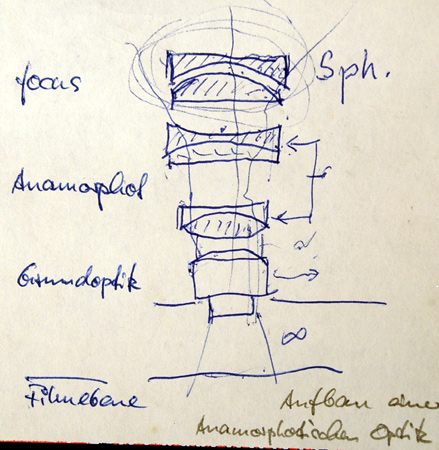 Jan
Jacobsen's drawing of his anamorphic lensen for ARRI. Image from Gerhard's collection Jan
Jacobsen's drawing of his anamorphic lensen for ARRI. Image from Gerhard's collectionTHa: I think we should jump to Jan Jacobsen – GF: Yes, OK. THa: Tell us about your friendship with Jan; how did you meet him? GF: I met Jan Jacobsen because Peter Rohe was working there and he told me I must meet Mr. Jacobsen, he is such an interesting technical person and a genius with optics and mechanics. So Peter took me to the company and I had a very long speech with Mr. Jacobsen about techniques and about lenses. So we met many times, and when I had my machine shop - I bought a machine shop later on - Jan came very often to make little pieces, or even bigger ones. When he started to make his camera – the Re-Can [lit.: “back in the tin-box”] camera was its name - he made many of his parts in my machine shop, and he got the permission to come whenever he wanted. And I went many times to his house to make tests. He had funny ideas, some of them didn’t work, but he always had something new like the dual screen front projection he got an Oscar for. Or, he had a system with a flipping focus, that was a little optical element in front of the lens, and it was driven by a shaft from the camera so the focus was always swept from the front to the back, and so on. This was made for front projection with VistaVision because the screen is very unsharp because of the long lenses. And with this system it was able to put two pictures on one frame of the film. |
|
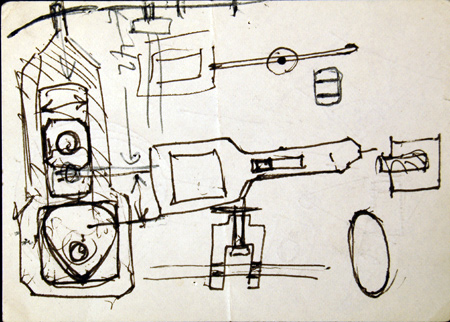 Jan
Jacobsen's illustrations of one of his ideas. Image from Gerhard's
collection Jan
Jacobsen's illustrations of one of his ideas. Image from Gerhard's
collectionTHa: Two pictures on one frame of film... GF: Two pictures on one frame. This was adjusted to the camera so when the shutter opened first, one frame was exposed in front, with the focus on the actor. Then the optical system was driven back, and the focus was on the screen. But the problem was, the actors had to be exposed with flashlight, with stroboscope light, so the flash was very bad for the actors. When the focus was in front, the flash exposed the picture in front and then, switchover, and the front projection was exposed to the same frame. Can you imagine, Yes? |
|
 Gerhard
in his workshop. Image from Gerhard's collection Gerhard
in his workshop. Image from Gerhard's collectionTHa: It’s difficult, I’d have to see the frames to understand! GF: You don’t see on the frame...you only see that the man is in focus and also the screen. But with VistaVision the screen is normally very unsharp because of the long lenses – they had to be twice as long. So this was developed and we made tests. But you can’t stand it as an actor. You know, you always make flash – flash, flash, flashes [laughs]. [Break] GF: Yes, you must understand Jan had a very, very small machine – a drehbank [lathe] - and he had made himself a little block to use it as a milling machine. And with this little machine, it was a Mayford, an English machine, he did unbelievable things. He built an IMAX camera by himself, always in his own shop. Only little pieces for the movement also. He came to my machine shop to make bigger parts. |
|
Jan Builds IMAX |
|
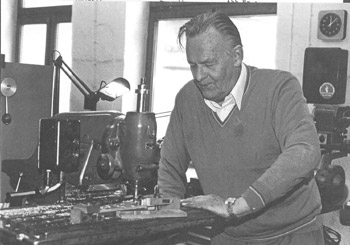 Jan
Jacobsen in his machine shop in Munich, Germany. Picture from Gerhard's
collection. Jan
Jacobsen in his machine shop in Munich, Germany. Picture from Gerhard's
collection.THa: Tell us about Jan Jacobsen and IMAX – GF: The IMAX people started with Arnold & Richter with 5 cameras, with 5 Arriflexes. And this was invented for the world trade show in Ottowa, I think. And after this exhibition they thought to change the system, because with the 5 cameras and the 5 frames of the five different films, like from Cinerama or Cinemiracle, they always used to use all the difference between one or the others. So they wanted the possibility to make one film and a big wide screen. And they started with the IMAX system, which means 65mm film running horizontal and 15 perfs wide. So this was a tremendous big format, and they had the idea and they had made some tests with photo cameras, specially-made photo cameras. But nobody was able to make a film camera for them. They couldn’t find one, because it is a very, very long way for 15 perf. And then they had known Jan Jacobsen, just heard of him, he was living in London in those days. And they asked him to come to Toronto and start to make a camera, and Jan came over to Toronto and in a very, very short time he had the movement for the IMAX camera. |
|
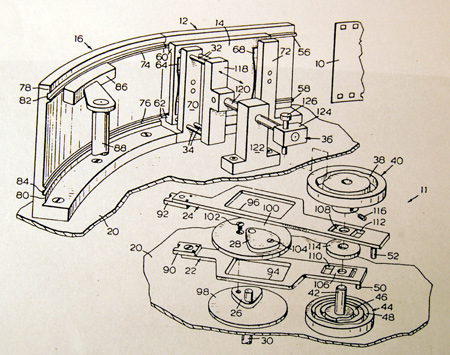 65mm
15 perf movement patent illustration. Image from gerhard's collection 65mm
15 perf movement patent illustration. Image from gerhard's collectionAnd he had a brand new idea, because he made two movements in the camera; one movement was turning the film 7 and a half frames, and then it went out and the next movement goes in, and makes also 7 point 5. And then those make one empty turn, and then one goes in, the other goes in, then an empty turn, and so in a very short time he got the IMAX system running. So they made those cameras and it was fantastic, they were very happy. But they couldn’t make a projector either, because the - what is the name – the Geneva Cross – it didn’t work for this big format, it just took the film in parts. But Jan Jacobsen had seen a newspaper from Australia, and somebody in Australia had invented the rolling loop system. Now I can show you the rolling loop system; I can explain how it works; but if you would read something about the rolling loop system I think nobody would understand it. |
|
|
But Jan had a little short article in a newspaper he found and said,
“This is the idea for your projector!”. And he went to the IMAX people
and said, “Go to Australia, get this man, he is making your projection
system”. He had seen only the short article. And so they went to
Australia and they found out that it really worked for their big format
because the film is not touched or moved by any movement, any
transportation pins. It falls into adjusting pins, but it is not moved
by the pins. So they developed this projection machine, and so this IMAX system was born and was working, and was sold worldwide. THa: Tomorrow we should go upstairs and have a demonstration of the rolling loop... GF: Yes, OK... I didn’t understand when Jan told me first of the system, I didn’t understand it. THa: See it in Copenhagen where we could take the rotor off the projector, then you’ll understand it! GF: Yes of course, that’s why I have the small magazine on top of this camera to get it in my car and show it to my students in Ludwigsburg. Otherwise with the big 300 metre mag I couldn’t transport it. It looks a little bit funny with the small magazine! |
|
Teaching Camera Techniques |
|
 Gerhard
explaining something to Orla Nielsen. Image by Thomas Hauerslev Gerhard
explaining something to Orla Nielsen. Image by Thomas HauerslevTHa: Tell us about your teaching – what are you teaching? GF: In Ludwigsburg I’m teaching 35mm techniche. You know, the students that use 16mm equipment like ARRI ST or SR, after that they must come to hear my referat [seminar] and we make some theoretical stuff about film format and different techniques in movement. And I show them really working movements that you don’t see normally, because it is hidden in the black box in the camera. And then we have two days training on the cameras. They have to learn how to load the magazines, and how to put the camera together, and how to put the tripod on the ground. You see, I would teach that the legs of the spider are too close together; the camera is not steady like this. Something like that. And after that, later on, they have to make a little – what do you say – an examination, they have to go to another teacher and to answer some questions – THa: Exams? GF: Exams, Yes. After my excus is ready I go back to Munich, but they have to go to another teacher. And he will make an examen and ask then some stuff, what currency is a 16 BL, or what lens mount is Arriflex, and what is name of the next Arriflex Mount; standard mount and steel mount and PL mount. And when they have good answers they get a 35mm paper and then they can get different 35mm equipment from the pool, from rental. And this is two times every year. I go there in February and then in July again, and I do this since 14 years, I think. |
|
UltraScope |
|
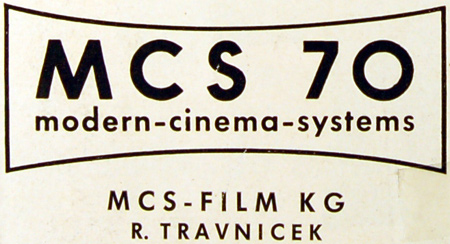 THa: Let’s talk about Jan and the Ultrascope lenses. THa: Let’s talk about Jan and the Ultrascope lenses.GF: When CinemaScope came out they had a patent on it, a very strong American patent. So everyone who wanted to project a CinemaScope film, or to shoot films in CinemaScope format, had to rent the lenses from Todd-AO [20th Century Fox, Ed]. And Arnold & Richter of course didn’t want to pay rent for those lenses to America. And they had heard that Jan Jacobsen was a genius with optics, so they called him from London, got him over to Munich and gave him the order to make a system with CinemaScope lenses. And Arnold & Richter had a really good optical system company in Stephanskirchen, and they could also make those anamorphotic lenses. However, nobody was able to make the design or to get the lenses working. And Jan came in, and in those days they had just a ground optic, a normal spherical lens, and put an anamorphotic block in front. But the more wide angle the lenses were, the bigger was the CinemaScope block. So it was somehow...somewhere was the aim of making wide angle lenses. So Jan had an idea, he said, “Why should I compress a picture in front? I can make it in two parts; 1 to 1.4 in front, but in the rear I make an [anamorphic] element that takes the picture behind the [wide angle] lens”. And so he made very, very compact lenses, and he was able to make wide angle lenses with this system. He got some problems with the main design. Mr. Kästner said it is impossible, it is against any optical order, but Jan went to Liechtenstein - he knew a little company there - and he told the people to make him the special lenses, and he himself made an optic out of it, and it worked! So ARRI was the first company that made compact wide angle lenses with focussing inside the lens, not in front like the other one had. With these very early CinemaScope lenses you had to turn the focus in both directions, the ground lens this way, and the CinemaScope lens the other way; it was terrible to work with. And they got a patent on it, and Jan Jacobsen got money for 18 years for this patent. This was the ground level for him to live, because he had no money from the state. What do you say when you are retired? THa: Pension - GF: He didn’t get any of those, so this was a very good basis for his ideas to work on. THa: Can you tell where did he live compared to Munich? Did he live in München? GF: No. Jan Jacobsen was married with a German woman and she had a relative who was an architect. He was building little houses, and so he came to a little, little village near Augsburg, and there he was living and he had a basement where he had his machine shop. And this was about 60 or 65 kilometres from Munich, and he has a son and a daughter. The daughter is married with an American fellow and living in the United States, and Jan Junior is also mechanic and interested in electronics; he is with a company...I don’t know...in Vertingen. They make doors for garages. And he is still very much interested in the film business. |
|
Gerhard's Interests |
|
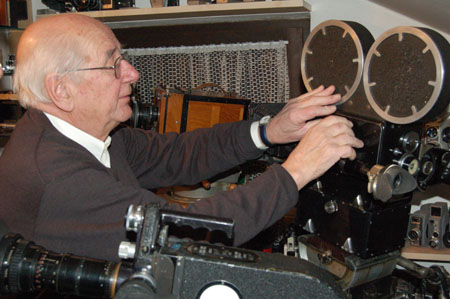 Gerhard
explaining how a 35mm camera works. Image by Thomas Hauerslev Gerhard
explaining how a 35mm camera works. Image by Thomas HauerslevTHa: Jumping to something completely different – what is your favourite interest in movies today; what do you like about the movies? GF: I like my cameras especially...I have a collection of some 100 film – movie cameras, and I like to repair them or adapt to a different system, so that’s what I like. But sometimes I like to go to good cinemas, and so it’s my interest...film was my life...all my life - in different ways. I was writing these articles about film cameras and I was repairing them, and I had a company to make a shoulder magazine for Arriflex, or rain deflectors for "Das Boot", or underwater housing for "Das Boot". And for one very little small underwater camera I used ARRI parts; the movement, magazine is all ARRI, but it is taken on a different way together, so it is a very small little camera, only 8.5 kilos with 60 metre 35mm magazines. |
|
Explain IMAX |
|
 15
perf 65mm DEMAX camera. Image by Thomas Hauerslev 15
perf 65mm DEMAX camera. Image by Thomas HauerslevTHa: OK, Gerhard, we’re standing with the camera, in your house, and your collection, and- can you explain to us what this camera is, please? GF: Yes, this is a camera for the IMAX format. The company was named DEMAX, because we were not allowed to use IMAX, it is by patent, and there was a company in Germany, they wanted their own camera for IMAX format. And this one was built by many different people; for example, the movement was made by Wolfgang Weigel, and the mechanics, magazines and the body were made by my company. As you can see here. And the electronics were made by former electronics people from Arnold & Richter’s. And it was nearly ready, but the two films we wanted to go on, they were Trans-Siberian Railroad and part of Mr. Däniken, they didn’t get money to produce these films any more, so the company cancelled the project, even though it was nearly ready. They cancelled it, and the company left the rooms, and had no space, so they asked me if I wanted to have the camera for my collection. But it was really nearly ready, you can see the viewing system has a video assist, and you also can swing around and take it apart like a normal camera, but the lenses didn’t get ready, there’s no mirror, no lens in - it’s a dummy – the viewing system is just a dummy. |
|
 Gerhard, explains how his 15/65mm DEMAX format camera works. Image by Thomas Hauerslev Gerhard, explains how his 15/65mm DEMAX format camera works. Image by Thomas HauerslevJust to show how the camera would have looked. It was planned to use Hasselblad lenses, but because they are very expensive, I now have a Russian lens from a Kowa 6x6 camera made in Russia. Just to show it. And these magazines we had made because you can buy 65mm film only in 300 metre rolls. So we had to make a magazine with 150 metres. Before, we had only magazines with 120 metres, and it was very difficult to cut one 300 metre roll into two parts, two pieces, and you had to throw a lot away. So with 150 metre magazines it was possible just to cut one time 300 metre roll; that’s why we have this 150 metre one. Yes, pity it’s not ready. And it did work, and we did some tests, but now it is something only for my museum. GF: Yes, you see the IMAX system is 15 perf. On a 65mm negative – can you see it like this? It’s 15 perf on a horizontal driving film, so it’s one of the biggest formats in the world. It is 72mm by 56 mm, and in one second there are running 1 metre 80 centimetres through the camera. It is quite a lot of stuff. In the beginning they started the IMAX format with 30 frames a second, but later on they found out it’s better to get down to 24 like all the normal cameras. And you can see here the movement - that is 15 perf going from right to left - not like other cameras where film is running vertical. This is film running horizontal. So that was the possibility to make such a big format. And this one has not a real mirror reflex, it has just a pellicle so you lose a little bit of light. But it was a very easy possibility to make the camera as small as possible. And we wanted to use the camera in a helicopter and stuff like this. So it’s a little bit smaller than all the other IMAX cameras. |
|
 DEMAX
logo,
German produced 15/65mm camera. DEMAX
logo,
German produced 15/65mm camera.THa: And what’s the small frame coming in? GF: That’s a ventilator that puts air back to the film. It is pressed to the back of the run. It was a problem with Jan Jacobsen’s camera – this one had no ventilator, and so the film during exposure did a little bit of floating. And this means it gets a little bit out of focus, in the middle of the frame. Not on the end, but in the middle. So that was the reason we used this ventilator, to get the film pressed to the back. THa: When was it made, this camera? GF: You see there was a person, Friedrich Kluetsch, he was very much interested in big format films, and he was on the film "Ocean Men", and so he was really a friend of IMAX. And he started to build this camera, maybe in the late ‘90s or 1995. And he organised the people. As I told you, the mechanics were made by Wolfgang Weigel, electronics by Yuen from Vietnam - he was a former employee of Arnold & Richter’s - and magazines as you can see were ready by 1997. So shortly after, this system stopped, because they didn’t get money to make the last two films for IMAX. THa: How much time will this 150 metres run for? GF: You ask me too much! In one second there is running one metre eighty through the camera. So I must get my calculator, I can tell you. [Laughs] |
|
Under Water Housings |
|
 Gerhard
Fromm surrounded by cameras of all size and shapes. Image by Thomas
Hauerslev Gerhard
Fromm surrounded by cameras of all size and shapes. Image by Thomas
HauerslevGF: Now we are in the corner where I have my old underwater housings. I was always interested in diving, in scuba diving, and I started with just a small 16mm housing and then a 35mm housing, but I had always trouble with the customs in Israel, you know when you came in you had to go through all this customs stuff. And one time I was told that somebody would come to Photokina because I told them that I had shot some test films and they were going to show in Photokina, and in fact one of the [staff] from the embassy - from Bonn in those days - came over to Cologne to check out that I was showing this film. OK, now I have built the very small camera like this, it is a 35mm camera, it’s got a housing for a camera, only we used the movement and the mirror system off an Arriflex 2C. And we adapted the magazine to our housing so it was very small, and we cut the mouth [magazine opening] into two pieces. We put one piece here, and one piece here, and the film is run through this roller into this half of the mouth, into the gate. And then back to the magazine. So this was the possibility to make it that small. And it was possible to change magazines, so the Assistant on board was able to load one magazine and then get a new one immediately. So the cameraman in the water didn’t have to wait a long time. And also you can see we had a battery. It was possible to change it immediately you know, in seconds. And we used only 16mm Distagon lenses. But it worked perfectly and we never had problems with customs, because they thought it was an amateur camera. Many of the 16mm or 8mm cameras had the same size, like this 35mm camera. I was very happy with it; I was many times on the Maldives and in the Red Sea, filming with this camera, for advertising films and stuff like that. And there is an O-ring around here, so when you close the housing you press together, all around the O-ring, the rubber ring. And to open it, you need this [demonstrates] and you have to press it out, because it’s really tight, and the water is pressing in, and makes it even more tight. And you see if I pan it over here, it opens up and you can take it out. THa: How deep does it go? GF: Oh, the man who made the housing said about 30 metres. Not more, because it is only plastic. |
|
Working with Leni Riefenstahl |
|
 Gerhard
proudly shows a book cover with Leni Riefenstal in Africa. Image by Thomas Hauerslev Gerhard
proudly shows a book cover with Leni Riefenstal in Africa. Image by Thomas HauerslevGF: This is Leni Riefenstahl in the Nuba Mountains [Sudan], with little kids, she enjoyed teaching the little kids, and gave them some toys and everything. And it was a really interesting journey, about 1964, and you see – [shows photos] it was sometimes big meetings, especially when somebody died. They had a party for three days or so. And very kind people, these Nuba; we didn’t have any fight or problems with them, only when they had their big parties, they had wrestling [traditional wrestling competitions]. And they always had music. They liked to play around, like this [shows photos]. Here you see one Nuba; he used one of those guitars [a Rababa], made out of cowhide. And you see both of these young men had one of these guitars and made very stupid music all day long! Girls were working in one of these houses. They were very busy. The men liked to work in the field. You saw jura, that was [germinated] corn. Most of the time they had only jura corn for lunch and for dinner. Here they are coming back from the fields with the jura on top, and then it came on a roof like this to get dry. |
|
 Leni
Riefenstal dressed to do what she loved the most - underwater
photography. Image of dust cover by Thomas Hauerslev Leni
Riefenstal dressed to do what she loved the most - underwater
photography. Image of dust cover by Thomas HauerslevThey made beautiful designs when they went to the parties, the fiestas, and Leni loved them, because they were really beautiful people. They were a really very friendly people. When they had those parties, the young men had fights and wrestling. For example, with this shield, two persons fought against each other with a spear. And they tried to destroy the shield of the other guy. And when they had a hole the first time, they didn’t like it anymore, they threw it away. So I got one of these shields to take home. THa: Do you have any good anecdotes about Leni Riefenstahl, what kind of movies did she like? GF: Oh we didn’t talk about the movies. She only told me about "The Blue Light" and the time with Dr. Arnold Fanck, he was a famous director of mountain films. She was often telling stories about Dr. Fanck...was very interesting. And she was with Luis Trenker, he was a very famous actor and a mountain climber. And one of the cameramen on the Olympic Games was Hannes “Floh” Schneeberger - and he was a nice guy and told many stories because he was flying with [Ernst] Udet, a very famous pilot. And they were going with the plane, under a bridge on the Isar river and Floh did the filming, filming out of the plane, and they also went to the mountains, and Udet landed on a glacier, and they made funny things. Udet was a very, very famous pilot, and a very good one. THa: How was it to be together with Leni Riefenstahl? |
|
 Leni's
photographer _____. Image by Thomas Hauerslev Leni's
photographer _____. Image by Thomas HauerslevGF: Oh we had no problems together, no. She came in every morning and said I want to do this and this, she had a little script, and depending on the weather we went to different places. We drove with our Volkswagen buses to little villages and did some filming, or on a field where they made this jura. We just made our work. THa: Did you keep in contact with her? GF: Later on we wrote letters, and I was going to the Maldives one time and she was on the neighbouring island, but she couldn’t manage to meet me. We didn’t have a boat to go there. But we had a little bit of contact. THa: And what about the 100 years Anniversary? GF: [Laughs] Yes, when Leni Riefenstahl got her hundred years she invited 250 people to her birthday party. And we made a little party here in my garden, I invited some friends to show my slides. And we had a big tent, and a screen, so it was fun. But Leni Riefenstahl went two days after her hundredth birthday down to the Maldives for diving. She made a very good book, with underwater pictures. And the film is a very, very beautiful film – an Underwater film ["Impressionen unter Wasser"]. GF: Here are some of the pictures that Leni Riefenstahl had in this book about the underwater scuba diving. And she had also made a very, very beautiful movie about diving. This is the fish, you could nearly come and see it, here are the eyes and the mouth. There are some very ugly and poisonous animals underwater. This one, if you meet him, in about 5 metres depth, and if you touch his neck and you can’t get up soon enough to the surface...you won’t meet anybody anymore! |
|
 Orla
photographing a book. Image by Thomas Hauerslev Orla
photographing a book. Image by Thomas Hauerslev[Leafs through pages] After the expedition I was on, she started to make a new expedition, to another Tribe of Nuba Mountains, The Nuba of Kau. And she had another cameraman for this film, and he was a diver too, and introduced Leni Riefenstahl to diving. She wanted to take the diving exam, and in those days she was 72, and she told a little lie on the paper, that she was only 62, and so she got permission, and they made a lot of films together and took pictures together. And Leni was feeling that the end was coming, so she married him because of the rights on the film and everything – there were no problems. And Horst Kettner now is cutting films, making little news stories and also underwater films, giving it to television stations. You should see here, that is a beautiful picture...I’m not so beautiful! This is Leni diving - [Leafs through pages] [Looking at photos of Leni Riefenstahl] GF: she was a beautiful girl when she was young...in those days she was really beautiful. I have another book from this time, the early times. The book has the name, “Five Lives” because she started as a dancer. THa: Did she work with colour? Or black-and-white? Or both? GF: Both! THa: Where are those films today? GF: Horst Kettner has them. [Break] |
|
Jan Jacobsen's Re-Can Camera |
|
 Gerhard
explaining Jan Jacobsen's re-can 16mm camera. Image by Thomas Hauerslev Gerhard
explaining Jan Jacobsen's re-can 16mm camera. Image by Thomas HauerslevGF: Ah, you see this camera was made by Jan Jacobsen, he gave it the name “Re-Can”. In those days there was a big interest in having a camera to get the picture of a high-definition monitor back to film. And so he used - this is only for demonstration at the Film Academy, normally we had a 300 metre 16mm Mitchell magazine but I can’t transport it in my car - so I have this little magazine and you see, he used a rolling loop system which was invented by an Australian, and it works like that. And here is a piece of film coming in to this hole, but the film is steady because of adjusting pins close to the gate. But this drum is turning around, 25 times a second, and brings this wave of film. It is just one height of a 16mm picture, it brings it to the gate. |
|
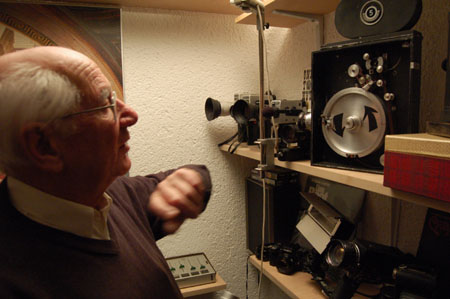 Jan
Jacobsen's re-can 16mm camera. Image by Thomas Hauerslev Jan
Jacobsen's re-can 16mm camera. Image by Thomas HauerslevTo explain the rolling loop system to you, it’s better to see a really working machine. You see a drum here with a little hole on one side, this was rotating 25 times a second, and the drum brings one piece of film like a wave to the gate. Close to the gate are some adjusting pins holding the film, so when this wave comes to the gate you can see the film can get out of the adjusting pin, and the next picture is laying into the adjusting pin, and the drum turns back and gets one more frame of film and brings it like a wave. But the film is steady in here, till the wave comes to the gate and then it gets out, and the next one gets in and the film gets out of the drum and is going back to the magazine. This system was really working, and there would have been a very big interest for it, because we wanted to get film of the video and off the television, TV series and everything, and Jan made very good tests. But with the electronics of those days it was not possible to get the camera synchronised to the electronic beam. The change of one film frame to the next must happen when the beam on the [TV] screen goes back from the last line to the top line! |
|
NASA Vertex |
|
 Gerhard
explaining ARRI's NASA camera. Image by Thomas Hauerslev Gerhard
explaining ARRI's NASA camera. Image by Thomas HauerslevGF: Here’s a very interesting camera; it is an Arriflex without flex! That is a very funny thing because it was made for NASA; the name is Vertex - Vertical Take-off Experimental. And those cameras were made in about 400 pieces, for NASA, and were put on rockets to show the burning of the engine. And when the magazine was full up, here was a little switch, this got blown away and the magazine came down to the earth on a parachute, and they had special planes, twin engine planes with a fork [catching apparatus] in front, and they picked the magazines up and brought them back to see what the engines were doing. This has no reflex inside, it is a very thin metal shutter, it’s not a mirror, it’s just a thin metal [shutter]. And because they were fixed on the rockets, and all the cameras fell into the ocean, and because they only needed the magazines, there was a memo going through the company, “Listen this is our best order, because there were 480 cameras sold and not one came back, no reclamation”. So this was really a good order. And you can see, it has not a normal drive axis, it was driven by an extra motor, maybe compressed air, or something like that. And this is the last one I think that is still working. All the others you can fish out of the Atlantic! So we have seen it has no reflex viewing, it is just thin metal. But the same gate, it is like the Arriflex 2C but full frame, like silent movies. And the normal movement. And this is an end of film switch; when the magazine was full, it was blown away from the camera, and came down with a parachute, and they had special planes with twin engines, and in front of the pilot there was a [catching] fork and they caught the parachute to see what the engines on the rocket made. |
|
Vintage Projection |
|
 Gerhard
and Orla enjoying hand cranked 35mm film. Image by Thomas Hauerslev Gerhard
and Orla enjoying hand cranked 35mm film. Image by Thomas HauerslevGF: So this is a projection machine, the patent is dated 6th August 1904 and it was standing in the Black Forest in a cinema, and was only used as a hand crank for the beginning, and later on it was just in front of the cashier for decoration. Two years ago I bought it in a flea market in Munich. But you see everything is nearly original, and I can show you how it works - you just turn the wheels and you see a picture on the wall! The operator had to get two turns a second to get the same speed (16fps!) like the cameraman had with the camera. And the interesting thing is you can use the housing with a light [lamphouse] pushed over, and on the other side here is a possibility to project advertising slides. It was like it was in the last years, to show people advertising, both together in the one projection machine. |
|
Epilogue - coming soon |
|
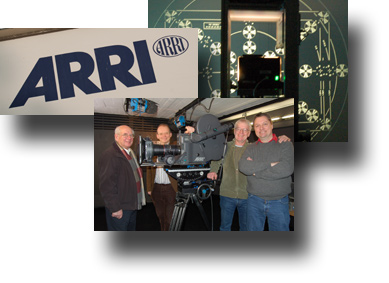 Read all about the visit to München, Gerhard Fromm, ARRI Group, Royal Palast
cinema, train spotting and the schnitzel. Read all about the visit to München, Gerhard Fromm, ARRI Group, Royal Palast
cinema, train spotting and the schnitzel.• A Visit to ARRI in München • Re-visiting Large Format With Gerhard Fromm |
|
|
Go: back
- top - back issues
- news index Updated 22-01-25 |
|
